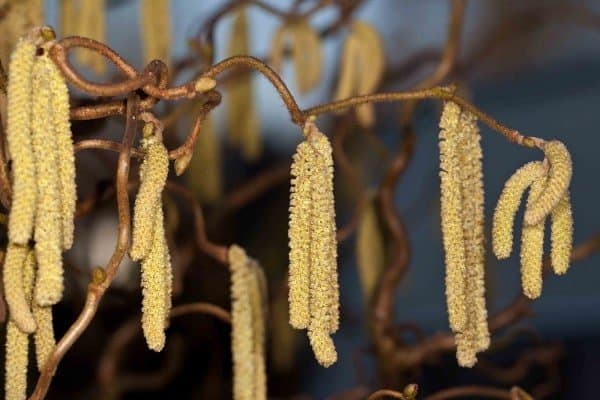Some years ago, I had a splendid corkscrew hazel (Corylus avellana ‘Contorta’, Zone 5), sometimes referred to as Harry Lauder’s walking stick, planted at the corner of a brick wall. Stonemasons ripped it out of the ground in haste when a crack in the house foundation required immediate repair and, sad to say, the shrub didn’t survive. I was unable to find a corkscrew hazel of appropriate size that season, and replaced it with a conifer.

But that hazel shrub lingers in the back of my mind, because it looked splendid in winter with its curled and twisted stems, and long, elegant catkins in spring. The dangling catkins are pale yellow male flowers that lengthen as temperatures begin to warm at winter’s end. When fully extended, breezes rippling through the catkins produce little puffs of pollen for a day or two (but seldom any nut fruits).
Woody plant expert Michael Dirr says ‘Contorta’ wasn’t bred by plant scientists, but discovered about 1863 growing in a hedgerow at Frocester, Gloucestershire, England. The woody tendrils and branches, as well as the foliage, have a rippling effect, and a mature plant is quite dramatic in winter. The thicker wood develops a shiny, almost silvery, surface that glints in bright winter sun. Some of the thinner branches and tendrils curl into a corkscrew form and add delightful detail.
The branches are valuable for flower arrangements, and fortunately the shrub benefits from light pruning once or twice a year. The way to get lots of curling wood is to grow ‘Contorta’ in full sun and keep it well watered. It will grow in shade, but the wood is not so dramatically contorted in shade, and growth is slower.
Corkscrew hazel usually grows wider than tall, and can easily be kept to four feet (1.2 m) high and wide with light pruning. You can sometimes find tall specimens in plant nurseries, often sold with a stake, which is probably necessary in winter winds.
‘Contorta’ is usually a grafted plant, and the rootstock (a species of hazel) often sends up suckers or shoots from below ground near the trunk. Remove them with hand pruners or they’ll quickly grow to overwhelm the fancy twisted wood above. You can easily recognize the suckers, as they are straight with no curves.
There are new foliage colours and forms available, including yellow (‘Aurea’), purple-red (‘Rosita’ and ‘Red Majestic’), and lace leaf (‘Laciniata’, syn. ‘Heterophylla’). Depending upon how many “wow” effects you require in your garden, go ahead and make yourself happy!
Other posts by Judith this week:
Posts by Judith last week:

I had an amazing Corkscrew Hazelnut. Unfortunately
I have only a few branches that live. It is substantial . 14 years old. I am saddened by its slow death . An arborist told me I had a blight 3 years ago . I had lost 3
Other small trees/ shrubs. I have called a local florist to see if they’re interested in taking the whole thing and removing it for free. Because I know how dear these treasured older hazelnuts are to florists and designers .
Where can I purchase one of these preferably in Canada
Hi Annie (March 8),
Yes, an interesting and unusual shrub, with ornamental value in four seasons. Can’t beat that!
— Judith
Wonderful introduction to this plant. It would be a great accent to any garden.